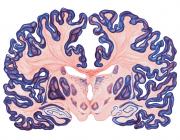The Anatomical and Functional Organization of the Human Visual Pulvinar.
Publication Year
2015
Type
Journal Article
Abstract
UNLABELLED: The pulvinar is the largest nucleus in the primate thalamus and contains extensive, reciprocal connections with visual cortex. Although the anatomical and functional organization of the pulvinar has been extensively studied in old and new world monkeys, little is known about the organization of the human pulvinar. Using high-resolution functional magnetic resonance imaging at 3 T, we identified two visual field maps within the ventral pulvinar, referred to as vPul1 and vPul2. Both maps contain an inversion of contralateral visual space with the upper visual field represented ventrally and the lower visual field represented dorsally. vPul1 and vPul2 border each other at the vertical meridian and share a representation of foveal space with iso-eccentricity lines extending across areal borders. Additional, coarse representations of contralateral visual space were identified within ventral medial and dorsal lateral portions of the pulvinar. Connectivity analyses on functional and diffusion imaging data revealed a strong distinction in thalamocortical connectivity between the dorsal and ventral pulvinar. The two maps in the ventral pulvinar were most strongly connected with early and extrastriate visual areas. Given the shared eccentricity representation and similarity in cortical connectivity, we propose that these two maps form a distinct visual field map cluster and perform related functions. The dorsal pulvinar was most strongly connected with parietal and frontal areas. The functional and anatomical organization observed within the human pulvinar was similar to the organization of the pulvinar in other primate species. SIGNIFICANCE STATEMENT: The anatomical organization and basic response properties of the visual pulvinar have been extensively studied in nonhuman primates. Yet, relatively little is known about the functional and anatomical organization of the human pulvinar. Using neuroimaging, we found multiple representations of visual space within the ventral human pulvinar and extensive topographically organized connectivity with visual cortex. This organization is similar to other nonhuman primates and provides additional support that the general organization of the pulvinar is consistent across the primate phylogenetic tree. These results suggest that the human pulvinar, like other primates, is well positioned to regulate corticocortical communication.
Keywords
Animals,
Oxygen,
Humans,
Photic Stimulation,
memory,
Female,
Male,
Adult,
Brain Mapping,
Visual Cortex,
Magnetic Resonance Imaging,
Visual Fields,
Visual Pathways,
Diffusion Magnetic Resonance Imaging,
Image Processing, Computer-Assisted,
Phylogeny,
Psychophysics,
Pulvinar,
Rest,
Saccades,
Young Adult
Journal
J Neurosci
Volume
35
Pages
9848-71
Date Published
07/2015
ISSN Number
1529-2401
Alternate Journal
J. Neurosci.
PMID
26156987

